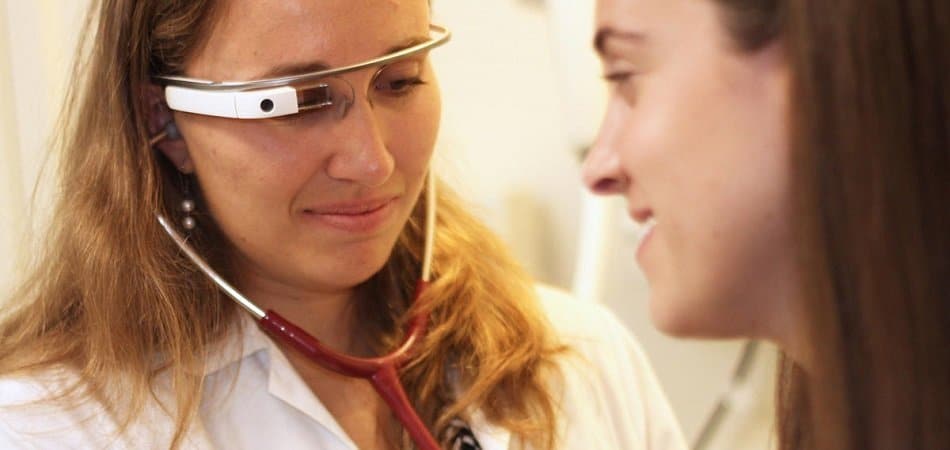Most people may associate augmented reality (AR) with smartphone apps and video games, perhaps even Pokemon Go. But augmented reality is gaining traction in a variety of industries, including manufacturing and healthcare.
The healthcare industry in particular may be poised to adopt AR into workflows as a cheaper alternative to AI for some use-cases. AI most often involves a lengthy and time-intensive integration, a complete overhaul of workflows, and an upgrade of employee skills.
This is not the case with AR; augmented reality solutions are much more like traditional software solutions: plug and play. That said, there are AR applications that involve artificial intelligence, although these are as of right now much less common in industry.
One such potential AI-enhanced AR use-case is Google Glass. Google Glass may have missed the mark with consumers, but the healthcare industry has expressed interest in making it work for physicians. Although it’s a nascent use-case, healthcare networks are looking to equip their doctors with Google Glass software that would allow them to see patient notes without taking their eyes off their patient.
This could allow physicians to be more present with patients during visits. In the future, AI startups may develop natural language processing-based (NLP) software and/or facial recognition technology that automatically pulls up a patient’s record with a voice command and transcribes notes about the visit into an electronic health record system.
There are startups that are looking to integrate NLP technology into their Google Glass-based service, but such a use-case is limited at the moment.
That said, there are a few vendors selling AR solutions to healthcare networks. In this article, we discuss two in particular: AccuVein and EchoPixel. The former purports its software can reduce the number of times a nurse or physician sticks a patient with a needle to find a vein. The latter claims its software can visualize 3D images of a patient’s organs and allow doctors to interact with those images. We start our analysis of augmented reality applications in healthcare with AccuVein.
AccuVein
AccuVein offers a namesake vein visualization device it claims can help medical professionals at healthcare organizations more easily find patients’ veins for blood draws. According to the company, this improves the patient experience and saves healthcare providers from having to do multiple “sticks.”
Accuvein claims that the handheld augmented reality device uses a near-infrared (NIR) 3D imaging system to detect veins. As the device is focused on a patient’s target area, the first IR detects hemoglobin in the veins through the patient’s skin. A photodetector receives light reflected from the patient’s target area, such as the arm or back of the hand, as a contrasted image. As the intensity of the first laser increases and goes deeper into the skin, the photodetector receives several vein images based on the depth.
Image processing algorithms then layer the images of veins according to their depth to create one image. Another laser emits a second wavelength of light and combines with the scanner to project a composite image of the veins onto the target area.
Below is a short 30-second video demonstrating how Accuvein illuminates the veins to assist clinicians in:
AccuVein claims to have helped four haemophilia treatment centres in France reduce the cases of difficult venous access (DVA) among patients. The study involved 450 participants. Among the total participants, access to the veins was reported to be difficult in 165 because they had poor vein condition, were too young, or were overweight. Of this number, actual difficulty in locating veins was encountered in 82.4%, and a fourth of these patients needed more than one puncture attempt.
Using the device, veins were difficult to locate in fewer DVA patients when the vein visualizer was used (76.0%) than when not used (92.3%). The case study also reported only 34% of the DVA patients reported being in pain during the puncturing when using the device, compared with 55.4% when not using the device.
AccuVein also lists Greiner Bio-One, Weber Facial Plastic Surgery, Sarah Bush Lincoln Health Center, and Carle Foundation Hospital as some of their past clients. The company has raised $30.4 million in funding from MVM Life Science Partners and Bessemer Venture Partners.
Joe Zott is the VP Engineering and Operations at AccuVein. He holds an MS in Electrical Engineering from the University of Maryland. Previously, Zott served as Principal at ZedTech, Engineering Director at Symbol Technologies, VP at iTV Corporation, among others.
EchoPixel
EchoPixel offers the True 3D medical visualization software, which it claims can help healthcare professionals visualize and interact with 3D images that depict human tissue and organs in open space as if they were real objects using augmented reality and image processing.
EchoPixel claims that the software is used as a pre-surgery software to simulate and evaluate surgical treatment options. Using it requires special glasses to view and a stylus to manipulate the images.
According to the company, the software uses machine learning to record the way doctors interact with the generated 3D image. As a result, other doctors can subsequently interact with the image in the same way previous doctors had. This likely reduces the time it takes for doctors across a healthcare network to familiarize themselves with the images the application generates. A video can be found on EchoPixel’s Vimeo channel.
EchoPixel claims to have helped doctors at the Lucile Packard Children’s Hospital Stanford precisely map the native vessels supplying the lungs of patients afflicted with pulmonary atresia (PA) with major aortopulmonary collateral arteries (MAPCA) prior to surgery.
Since each individual has a unique vascular structure, doctors used EchoPixel’s True 3D to capture the computed tomography angiography (CTA) images of a patient’s 774 vessel branches, and were used to plan and perform the surgery.
The researchers found that, compared with traditional 2D tomography techniques, the images captured by the True 3D Viewer improved the surgeon’s ability to see and interpret anatomical details rose to 90% from 81% previously.
The case study added that the time for physicians to interpret a tomographic readout declined to 13 ± 4 minutes using information from True 3D, compared with 22 ± 7 minutes in the past.
EchoPixel also lists University of California in San Francisco, The Cleveland Clinic, The Lahey Clinic, Boston Scientific, Deborah Heart and Lung Center, Toronto Sick Kids Hospital, and Nicklaus Children’s Hospital as some of their past clients. The tool is also being used for research efforts and training medical students in Penn State Health Milton S. Hershey Medical Center and Texas A&M Health Science Center College of Medicine.
The company has raised $14.3 million in funding from Aurus, 180 Degree Capital, Lam Research, Runa Capital. Intel Capital, and Binomial Ventures.
Sergio Aguirre is CEO at EchoPixel. He holds an MS in Electronics, Image processing and Stereoscopic Imaging from the Tecnologico de Monterrey. Previously, Aguirre served as CEO at Innouva Technologies de Mexico. The company also employs a Jeff Kasten, who holds a PhD in Biomedical Engineering.
Header image credit: TechRepublic



















